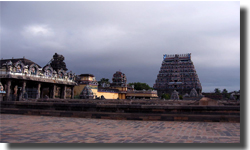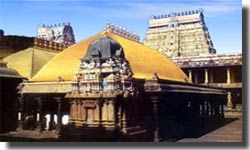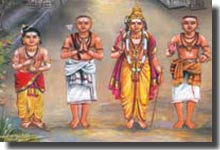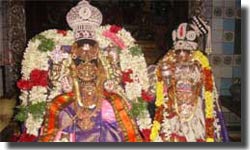Location :
Chidambaram Temple is a Hindu temple which is dedicated to Lord Shiva situated in the heart of the temple town of Chidambaram, TamilNadu. The temple is 78 km south of Pondicherry and 235 Km from Chennai which is the capital city of Tamil Nadu state of southeastern India.
Significance of the Temple
The Sangam classics which is referred to Viduvelvidugu Perumtaccan, respected clan of traditional Vishwakarmas, as being the chief architect of the temple renovation.There have been several renovations in its history, particularly during the days of Pallava/Chola emperors in ancient and pre-medieval periods.
Chidambaram is one among the five holiest Shiva temples, each representing one of the five natural elements; Chidambaram represents akasha (ether). The other four temples in this category are the Thiruvanaikaval Jambukeswara,Trichy (water), Kanchi Ekambareswara (earth) Kanchipuram, Thiruvannamalai Arunachaleswara (fire),Thiruvannamalai and Kalahasti Nathar (wind),Kalahasti.

Shiva is also worshipped in the "formless form" of the Chidambara Rahasyam, while the temple is known for its Akasa Lingam, an embodiment of Shiva as the formless Space. The word "Koyil" or temple in the Tamil Saivite tradition refers to none other than the Chidambaram Nataraja temple.

At the temple there is a stone image of Krishnadevaraya in the North Gopura which is said to have been erected by him. In the wars of the 18th century, this great temple was used as a fort, especially when the British General Sir Eyre Coote unsuccesfully tried to capture it from the Mysore Kings. During this period, the images of Nataraja and Sivakamasundari were housed in the Tiruvarur Tyagaraja temple for safety.

Legends associated with this temple are Aadi Sesha, the serpent (couch) of Vishnu, heard from Vishnu the grandeur of Shiva's cosmic dance. Filled with irrepressable desire to witness this dance in person at Chidambaram, the Seshan descended to the earth as Patanjali (the one who descended). Vyagrapaadar who is another devotee of Shiva prayed to obtain the tiger's claws so that he could obtain with ease the sacred Vilva leaves meant for Shiva's worship at Chidambaram. At the appointed hour, Shiva (with Sivakami) granted to Patanjali and Vyagrapaadar, a visual treat in the form of his Cosmic Dance of Bliss, to the accompaniments of music played by several divine personalities in the Hindu pantheon. This Dance of Bliss is said to have been witnessed by Vishnu, and there is a Govindaraja shrine in the Natarajar temple commemorating this. The dance of bliss of Shiva, is also said to have been enacted upon Shiva's (Bhikshatana) victory over the married ascetics of Daruka Vanam.

There is one more recent legend associated with this temple. The sacred Tamil works of the Nayanmaars had been missing for several years, and it was during the period of Raja Raja Chola (the builder of the Grand temple at Tanjavur) that formal research was initiated to trace these fine works of devotional literature. These works of the Saivite Saints - rich in musical content were recovered in a dilapidated state in one of the chambers in this vast temple, after the monarch brought images of the Saint trinity in procession to the temple.
Time to Visit
Best Season to visit the temple is from October to March. There are Two annual Bhrammotsavams at Chidambaram which are of great significance. They are Anithirumanjanam which is held in June-July, and Marghazhi Thiruvaadhirai held in December-January. During these festivals, the sacred shrine of Lord Nataraja is taken in a procession through the car streets, in the grand temple car, followed by a long anointing ceremony. These festivals are attended by large number of people. The Natyanjali Festival is dedicated to Lord Shiva and is held every year during February-March in the temple premises. It begins on the auspicious occasion of Maha Shivaratri and lasts for five days. During this festival, dancers from all over India, participate to pay their tribute to Lord Nataraja.
Accommodation Facilities at the Temple
The temple town of Chidambaram is the home to the Annamalai University, and it has several modern lodging facilities. The Tamilnadu Tourist Development here Corporation operates one of its hotels at Chidambaram. Chidambaram is located on the Chennai Tiruchirappalli Main line, between Villuppuram and Thanjavur. It is well connected with Chennai by a host of train and bus services.
| By road it is only 235 kilometers South of Chennai. Thanjavur is only about 100 kilometers away from Chidambaram. Chidambaram is literally the Northern gateway to the temple trough of Tamilnadu - the Thanjavur - Tiruvarur - Nagapattinam districts featuring hundreds and hundreds of ancient temples, which can be easily accessed from the towns of Mayiladuturai, Kumbhakonam, Thanjavur, Tiruvarur and Nagapattinam. | Near by tourist places to Chidambaram Temple Chennai Chidambaram Pondicherry |
 |
How to Reach the Temple
- By Roadways the Chidambaram is well connected by roads. Non-stop luxury buses operate from Chidambaram to Chennai Chidambaram is 245 km from Chennai and is well connected with several towns in the state. From here, there are bus services to Chennai, Pondicherry, Nagapattinam and Madurai.
- Through Railways Chidambaram is located on the Madras-Thiruchirapalli main line of the Southern Railway, which is connected withThiruchirapalli, Chennai, Bangalore, Madurai, Rameswharam and Tirupati. It is also connected with meter gauge rail link, main link going to Rameswaram via Kumbakonam, Thanjavur and Trichirappali.
- Through Airways The nearest Airport is Thiruchirapalli, 195 kms away and from where Indian Airlines connections are available to Chennai, Madurai and Sri Lanka. Umpteen buses ply daily to Chidambaram and via Chidambaram to various places.



